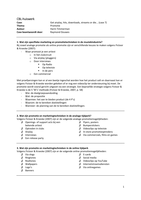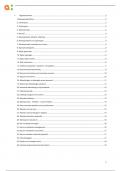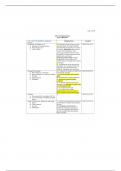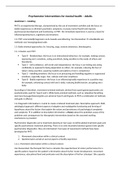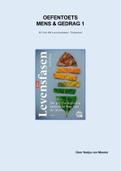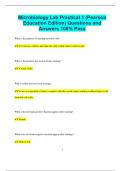Summary of Sustainable Development by Baker
Chapter 1
The exploration of policy options is international in its focus, because it recognizes that
promoting sustainable development is a quintessentially global task.
The conventional model
Conventional approaches see development as simply modernization of the globe along
Western lines. The modernization theory holds that the more structurally specialized and
differentiated a society is, the more modern and progressive it is. According Rostow, society
will to go through different “stages of economic growth”, assuming a linear progression, in
which it becomes necessary for Third World societies to “catch up” with the Western style of
development. This means opening up their economies to Western values, influences,
investment and trade, thereby becoming more integrated with the global market system.
Modern environmentalism challenges many of the basic assumptions that the Western
model of development makes about the use of nature and natural resources, the meaning of
progress and the ways in which society is governed. Seven key arguments form the backbone
of the environmentalist theory:
Progress in the Western model is understood in terms of increased domination over
nature and the use of her resources solely for the benefits of humankind. The
domination of nature has become a key indicator of human progress. The reduction
of nature merely to a natural resource base values nature only in terms of the use
that these resources have for human beings (instrumental value). The intrinsic value
is the value that nature has over and above its usefulness to humans.
The Western model prioritizes economic growth, even though the heightened
consumption patterns that it stimulates now threaten the very resource base upon
which future development depends. Environmental deterioration is seen to be an
inevitable consequence of development.
The model assumes that consumption is the most important contributor to human
welfare. Welfare is measured by means of ‘standard of living’, the amount of
disposable income that an individual has to purchase goods and services, not by
quality of life. It prioritizes individual self-attainment at the expense of consideration
of the common good, leading to increased inequality.
The model ignores the fact that social stability requires the maintenance of natural
resources. The deterioration of the environment causes social disruptions, insecurity
and damage to human health.
The traditional understanding ignores the fact that Western development is based
upon the exploitation of their own natural resource base and that of many Third
World societies, including their plant and animal genetic resources, land, timber and
mineral ore. Exploitation has caused under-development in the Third World, not least
by creating resource poverty and a culture of dependency. It also ignores the long
traditions of Third World societies and their indigenous knowledge, which has
enabled many traditional societies to live in harmony with their natural surroundings.
, The model is blind to the fact that it is not possible to achieve a global replication of
the resource-intensive, affluent lifestyle of the high consumption economies of the
North. The planet’s ecosystem cannot absorb the resultant pollution, as witnessed by
global environmental change and there are not enough resources, including water, to
support such development.
The conventional model does not acknowledge that there are limits to economic
growth, which are imposed by the carrying capacity of the planet (finite resources).
Technological advancement will not overcome this limitation.
The economic growth and prosperity was exceptional, as it cannot be replicated across space
or time. It was also contingent upon a short-term perspective, the prioritization of one region
of the globe over another, and upon giving preference to one species over the system as a
whole.
The emergence of a new model
- Aims at creating an ecological society that lives in harmony with nature.
- Promotes forms of social change, that are aimed at fulfilling material and non-
material needs, advancing social equity, expanding organizational effectiveness and
building human and technical capacity towards sustainability.
- Strives for sustainable production (reduce the resource intensity of production) and
sustainable consumption (reduce the levels of consumption).
The Brundtland formulation of sustainable development
- Has come to represent the mainstream thinking about the relationship between
environment and development.
- It now commands authoritative status, acting as a guiding principle of economic and
social development
The UN has played a particularly prominent role in stimulating engagement by organizing
several world summits, including the UNCED (Rio Earth Summit) in 1992, WSSD in 2002 and
the Rio+20 Conference in 2012.
- The Rio Declaration provides a set of normative principles, that is, principles that deal
with moral issues, including gender equity, intra-generational equity (within a
generation) and inter-generational equity (between generations).
- The summits have led to outlining of governance principles, global agreements and
the proliferation of institutions and organizations.
SD is a dynamic concept, as it is not about society reaching an end state nor about
establishing static structures. Promoting SD is about steering societal change at the interface
between the social, economic and ecological pillars.
- It is an ongoing process, whose desirable characteristics change over time, across
space and location and within different social, political, cultural and historical
contexts.
- It requires the engagement across all levels of social organization, international
collaboration in combination with efforts and participation of NGO’s, local and
national authorities and non-state actors.
, Chapter 2
Concerns about resource scarcity in the face of population rise and energy shortages can be
traced back to Malthus (1766-1834) and William Stanley Jevons (1835-1882). However, it
was not until the 1960s and the 1970s that unease about resource scarcity and unsustainable
patterns of use were expressed. The upcoming anxiety about the environment led to
critiques on the conventional growth-orientated economic development model.
In 1972 the Club of Rome Report, The Limits of Growth, was published, which concluded
that if present trends in population growth, food production, resource use and pollution
continued, the carrying capacity of the planet would be exceeded within the next 100 years.
Criticism mentioned that the report only focused on the physical to growth, ignoring the
possibility of technological innovations leading to new ways to address environmental
problems. It was also seen as an overly pessimistic view of the rate of resource depletion
globally.
Brundtland formulation
In 1987, when the WCED published its (Brundtland) report, Our Common Future, links
between the social, economic and ecological dimensions of development were explicitly
addressed. It prioritizes sustainable development, a model of societal change that, in
addition to traditional developmental objectives, has the objective of maintaining ecological
sustainability.
Brundtland definition:
“SD is development that meets the needs of the present without compromising the ability of
the future generations to meet their own needs”.
The definition received authoritative status because
- It offered a way of reconciling (=bring to an accord) what had appeared to be
conflicting societal goals
- It came at a time when the problem of environmental deterioration was high on the
political agenda.
- The definition supported developing countries in their pursuit of their goals of
economic and social improvements.
The Brundtland concept is global in its focus and makes the link between the fulfillment of
the needs of the world’s poor and the reduction in the want of the world’s rich. The
industrialized world consumes in excess of these basic needs, understanding development
primarily in terms of ever increasing material consumption.
The focus on SD presents a vision of the future that holds the promise of progress, opened
up through technological development and societal change. Still, ultimate limits to growth
are imposed by the ability of the biosphere to absorb the effects of human activities and the
need to adopt lifestyles within the planet’s ecological means. This results in seeing the health
of the ecosystem (natural capital) as a precondition for human life. The danger in this
approach is that it only sustains what is of instrumental value for human being.
One concept of SD acknowledges that there are limits to the amount of pressure that the
earth’s ecosystem can handle without irreversible damage. Crossing the planetary
boundaries could generate abrupt or irreversible environmental changes. The boundary
research served as a scientifically based framework to support the elaboration of SD at
Chapter 1
The exploration of policy options is international in its focus, because it recognizes that
promoting sustainable development is a quintessentially global task.
The conventional model
Conventional approaches see development as simply modernization of the globe along
Western lines. The modernization theory holds that the more structurally specialized and
differentiated a society is, the more modern and progressive it is. According Rostow, society
will to go through different “stages of economic growth”, assuming a linear progression, in
which it becomes necessary for Third World societies to “catch up” with the Western style of
development. This means opening up their economies to Western values, influences,
investment and trade, thereby becoming more integrated with the global market system.
Modern environmentalism challenges many of the basic assumptions that the Western
model of development makes about the use of nature and natural resources, the meaning of
progress and the ways in which society is governed. Seven key arguments form the backbone
of the environmentalist theory:
Progress in the Western model is understood in terms of increased domination over
nature and the use of her resources solely for the benefits of humankind. The
domination of nature has become a key indicator of human progress. The reduction
of nature merely to a natural resource base values nature only in terms of the use
that these resources have for human beings (instrumental value). The intrinsic value
is the value that nature has over and above its usefulness to humans.
The Western model prioritizes economic growth, even though the heightened
consumption patterns that it stimulates now threaten the very resource base upon
which future development depends. Environmental deterioration is seen to be an
inevitable consequence of development.
The model assumes that consumption is the most important contributor to human
welfare. Welfare is measured by means of ‘standard of living’, the amount of
disposable income that an individual has to purchase goods and services, not by
quality of life. It prioritizes individual self-attainment at the expense of consideration
of the common good, leading to increased inequality.
The model ignores the fact that social stability requires the maintenance of natural
resources. The deterioration of the environment causes social disruptions, insecurity
and damage to human health.
The traditional understanding ignores the fact that Western development is based
upon the exploitation of their own natural resource base and that of many Third
World societies, including their plant and animal genetic resources, land, timber and
mineral ore. Exploitation has caused under-development in the Third World, not least
by creating resource poverty and a culture of dependency. It also ignores the long
traditions of Third World societies and their indigenous knowledge, which has
enabled many traditional societies to live in harmony with their natural surroundings.
, The model is blind to the fact that it is not possible to achieve a global replication of
the resource-intensive, affluent lifestyle of the high consumption economies of the
North. The planet’s ecosystem cannot absorb the resultant pollution, as witnessed by
global environmental change and there are not enough resources, including water, to
support such development.
The conventional model does not acknowledge that there are limits to economic
growth, which are imposed by the carrying capacity of the planet (finite resources).
Technological advancement will not overcome this limitation.
The economic growth and prosperity was exceptional, as it cannot be replicated across space
or time. It was also contingent upon a short-term perspective, the prioritization of one region
of the globe over another, and upon giving preference to one species over the system as a
whole.
The emergence of a new model
- Aims at creating an ecological society that lives in harmony with nature.
- Promotes forms of social change, that are aimed at fulfilling material and non-
material needs, advancing social equity, expanding organizational effectiveness and
building human and technical capacity towards sustainability.
- Strives for sustainable production (reduce the resource intensity of production) and
sustainable consumption (reduce the levels of consumption).
The Brundtland formulation of sustainable development
- Has come to represent the mainstream thinking about the relationship between
environment and development.
- It now commands authoritative status, acting as a guiding principle of economic and
social development
The UN has played a particularly prominent role in stimulating engagement by organizing
several world summits, including the UNCED (Rio Earth Summit) in 1992, WSSD in 2002 and
the Rio+20 Conference in 2012.
- The Rio Declaration provides a set of normative principles, that is, principles that deal
with moral issues, including gender equity, intra-generational equity (within a
generation) and inter-generational equity (between generations).
- The summits have led to outlining of governance principles, global agreements and
the proliferation of institutions and organizations.
SD is a dynamic concept, as it is not about society reaching an end state nor about
establishing static structures. Promoting SD is about steering societal change at the interface
between the social, economic and ecological pillars.
- It is an ongoing process, whose desirable characteristics change over time, across
space and location and within different social, political, cultural and historical
contexts.
- It requires the engagement across all levels of social organization, international
collaboration in combination with efforts and participation of NGO’s, local and
national authorities and non-state actors.
, Chapter 2
Concerns about resource scarcity in the face of population rise and energy shortages can be
traced back to Malthus (1766-1834) and William Stanley Jevons (1835-1882). However, it
was not until the 1960s and the 1970s that unease about resource scarcity and unsustainable
patterns of use were expressed. The upcoming anxiety about the environment led to
critiques on the conventional growth-orientated economic development model.
In 1972 the Club of Rome Report, The Limits of Growth, was published, which concluded
that if present trends in population growth, food production, resource use and pollution
continued, the carrying capacity of the planet would be exceeded within the next 100 years.
Criticism mentioned that the report only focused on the physical to growth, ignoring the
possibility of technological innovations leading to new ways to address environmental
problems. It was also seen as an overly pessimistic view of the rate of resource depletion
globally.
Brundtland formulation
In 1987, when the WCED published its (Brundtland) report, Our Common Future, links
between the social, economic and ecological dimensions of development were explicitly
addressed. It prioritizes sustainable development, a model of societal change that, in
addition to traditional developmental objectives, has the objective of maintaining ecological
sustainability.
Brundtland definition:
“SD is development that meets the needs of the present without compromising the ability of
the future generations to meet their own needs”.
The definition received authoritative status because
- It offered a way of reconciling (=bring to an accord) what had appeared to be
conflicting societal goals
- It came at a time when the problem of environmental deterioration was high on the
political agenda.
- The definition supported developing countries in their pursuit of their goals of
economic and social improvements.
The Brundtland concept is global in its focus and makes the link between the fulfillment of
the needs of the world’s poor and the reduction in the want of the world’s rich. The
industrialized world consumes in excess of these basic needs, understanding development
primarily in terms of ever increasing material consumption.
The focus on SD presents a vision of the future that holds the promise of progress, opened
up through technological development and societal change. Still, ultimate limits to growth
are imposed by the ability of the biosphere to absorb the effects of human activities and the
need to adopt lifestyles within the planet’s ecological means. This results in seeing the health
of the ecosystem (natural capital) as a precondition for human life. The danger in this
approach is that it only sustains what is of instrumental value for human being.
One concept of SD acknowledges that there are limits to the amount of pressure that the
earth’s ecosystem can handle without irreversible damage. Crossing the planetary
boundaries could generate abrupt or irreversible environmental changes. The boundary
research served as a scientifically based framework to support the elaboration of SD at


